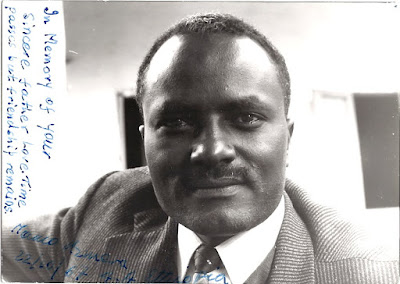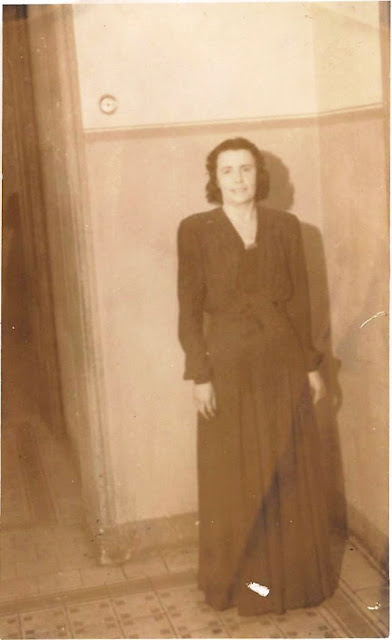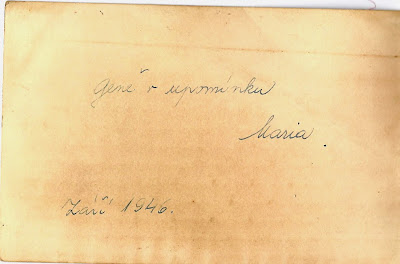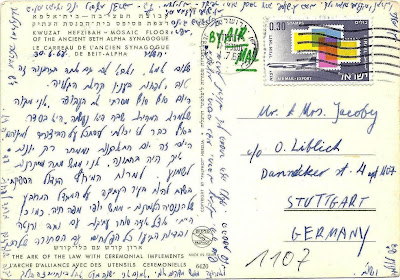When I just decided to start this blog, this was the first picture I scanned. I bought it quite a long time ago, and I've always really loved it.
כשרק החלטתי להתחיל את הבלוג הזה, זו היתה התמונה הראשונה שסרקתי. קניתי אותה די מזמן, ותמיד אהבתי אותה במיוחד.
There isn't much I can say about it, actually; there isn't much I can know. It's one of many pictures of anonymous people that I bought because something about them just clicked with me - sometimes with a few words on the back but often not even that - and I think that over the next few posts I'll be sharing these anonyms, in a way closer to what I envisioned when I started the blog: minimal explanations, mostly giving the stage to the pictures themselves.
Speaking of which, here's the picture.
אני לא יכולה לספר עליה הרבה, למען האמת; אני לא יכולה לדעת עליה הרבה. זו אחת מכמה תמונות של אנשים אלמונים שקניתי כי פשוט התחברתי אליהן בגלל פרט כזה או אחר - לפעמים עם כמה מלים בצד האחורי אבל לרוב אפילו זה לא - ונראה לי שלאורך הרשומות הקרובות אחלוק את האלמונים האלה, באופן שקרוב יחסית למה שחשבתי לעצמי כשהתחלתי את הבלוג: הסברים מינימליים, שישאירו את רוב הבמה לתמונות עצמן.
ואפרופו, הנה התמונה.
Front:
צד קדמי:
It's not a very good picture - it's blurry and faded, and the flash was a bit too drastic, and whoever took it apparently couldn't keep the camera straight - but in many other ways, it's wonderful. Mainly thanks to that woman. There's something almost regal about her posture. She's not young, and I can't say she's beautiful, but she has such a strong face. She doesn't look very happy, too, although that might just be a picture taken just at the wrong moment. Her dress is simple and severe, but looks well-fitted. And there's one piece of jewelry, which I think is a necklace but might be a sort of brooch or pin. It all combines to someone who feels like she must have had an impressive presence. She absolutely fascinates me.
זו לא תמונה טובה במיוחד - היא מטושטשת ודהויה, והפלאש היה קצת דרסטי מדי, ומי שצילם אותה ככל הנראה לא הצליח להחזיק את המצלמה ישר - אבל בכל מיני צורות אחרות היא פשוט נפלאה. בעיקר בזכות האשה הזו. יש משהו כמעט מלכותי בעמידה שלה. היא לא צעירה, ואני לא יכולה לומר שהיא יפה, אבל הפנים שלה כל כך חזקים. היא גם לא נראית שמחה במיוחד, למרות שאולי זו סתם תוצאה של צילום ברגע הלא-נכון. השמלה שלה פשוטה וחמורת-סבר, אבל נראית באיכות טובה. ויש גם תכשיט אחד, נדמה לי שזו מחרוזת אבל אולי זו איזושהי סיכה. כל הדברים האלה משתלבים לדמות שנדמית כמו מישהי עם אישיות מרשימה. היא ממש מרתקת אותי.
I think the picture was taken here in Israel, mostly because of the floor tiles and the general style of (what you can see of) the walls; it reminds me of the rich old Arabic houses in Jerusalem. That might just be a bias, or course - there might be similar styles elsewhere. I don't know. I also kinda get the feeling that the house is mostly empty, although it's very hard to tell from just one corner and a bit of corridor (by the way, is that another person standing back there, in the shadows, or is it a coat on a coat hanger? I can't tell). Maybe because it seems odd to take a picture just standing in the corner of a room, not sitting on a chair or leaning on a table or something, so it gives me the feeling that maybe there wasn't anything else there.
אני חושבת שהתמונה צולמה כאן בישראל, בעיקר בגלל המרצפות והסגנון הכללי של (מה שאפשר לראות מ-) הקירות; זה מזכיר לי את בתי-העשירים הערביים הישנים בירושלים. אולי זו סתם הטיה שלי, כמובן - יכולים להיות בתים דומים גם במקום אחר. אני לא יודעת. גם איכשהו יש לי הרגשה שהבית די ריק, אם כי מאוד קשה לדעת משהו כזה מתוך פינה אחת וקצת מסדרון (אגב, האם יש דמות של אדם נוסף בצללים שם מאחור, או שזה סתם מעיל על מתלה מעילים? קשה לי להחליט). אולי מפני שנראה לי קצת מוזר להצטלם ככה סתם בפינת החדר, לא בישיבה על כיסא או תוך הישענות על שולחן או משהו, אז מתקבלת הרגשה שאולי פשוט לא היה שם שום דבר.
Which gives me the mental picture of an immigrant. Someone who just moved to Israel, who doesn't have much with her, who maybe doesn't have much at all, but still carries herself with pride. Where did she come from, and when? Well, there's a partial answer for that, on the back. This was taken in 1946, and the message appears to be in Polish, from the little I managed to research.
ומכאן צומחת תמונה מנטלית של מהגרת. מישהי שרק עלתה לישראל, שאין לה הרבה, ואולי אין לה שום דבר בכלל, אבל עדיין יש בה גאווה. מאיפה היא באה, ומתי? יש רק תשובה חלקית לעניין הזה, בצד האחורי. התמונה צולמה ב-1946, והמסר שעליה נכתב כנראה בפולנית, לפי המעט שהצלחתי לחקור.
Back:
צד אחורי:
If anyone who happens to land on this post can read Polish, and can let me know what this says, I will be very grateful. At the moment, all I could find out is that 'upominku' (assuming I'm reading this right) apparently has something to do with gifts. Possibly. So really, all I have is the date, and the name Maria.
Is Maria the woman in the picture, or perhaps a friend? I don't know. Is the word before '1946' the name of the month or of a place? I don't know. I would really love to find out.
אם מישהו שמזדמן במקרה לרשומה הזו קורא פולנית, ויכול לומר לי מה כתוב שם, אהיה אסירת תודה. כרגע, כל מה שהצלחתי למצוא הוא שהמלה upominku (בהנחה שאני בכלל קוראת אותה נכון) נראית כאילו היא קשורה איכשהו למתנות. אולי. אז בעצם כל מה שיש לי זה תאריך, והשם מריה.
האם מריה היא האשה בתמונה, או אולי חברה שלה? אני לא יודעת. האם המלה שלפני '1946' היא שם החודש, או שם של מקום? אני לא יודעת. הייתי ממש שמחה לגלות את התשובות.
At the moment, all I have is what I can imagine. I imagine a woman, not very young, but not old either - maybe just a bit old-fashioned. I imagine that she came to Israel from Poland in 1946. This would mean that she has been in Poland during the war, and probably went through some pretty hard times, which would explain why she doesn't look happy. I imagine she doesn't have much, but she's proud and composed, and determined to start anew, because dammit, this is what you do. You pull through and you go on. I imagine that maybe she wasn't an easy person to deal with, but you have to respect her. I respect her, anyway, just going by this one picture.
כרגע, יש לי רק מה שאני יכולה לדמיין. אני מדמיינת אשה, לא צעירה במיוחד אבל גם לא זקנה - ואולי רק טיפה מיושנת. אני מדמיינת שהיא באה לישראל מפולין ב-1946. זאת אומרת שהיא היתה בפולין בזמן המלחמה, ומן הסתם עברה חוויות קשות למדי, מה שמסביר למה היא לא נראית שמחה. אני מדמיינת שאין לה הרבה, אבל היא שלווה וגאה, והיא נחושה בדעתה להתחיל מחדש, כי זה מה שצריך לעשות, לעזאזל. צריך להחזיק מעמד ולהמשיך הלאה. אני מדמיינת שאולי היא היתה בנאדם שדי קשה להסתדר איתו, אבל מישהי שצריך לכבד. אני מכבדת אותה, בכל אופן, רק בגלל התמונה הזו.
I don't know if any of these assumptions are even close to the truth, and I will probably never know. She's probably dead, by now; this, at least, is a fairly logical assumption. I hope she had a good life.
אני לא יודעת אם ההשערות האלה אפילו מתקרבות לאמת, וסביר להניח שאף פעם לא אדע. היא בטח כבר מתה, עכשיו; מכל ההשערות שלי, זו לפחות די הגיונית. אני מקווה שהיו לה חיים טובים.
Update, 15 Feb: A friend of a
friend looked at the card and says it's not Polish, and has no idea what language this actually is. So the story I imagined is somewhat less likely, I suppose. But I still like this mystery woman, all the same.
Once again, if anyone can read this, I would appreciate your help in translating the message.
עדכון, 15 בפברואר: חברה של
חבר הסתכלה על הכתוב ואמרה שזו לא פולנית, ושאין לה מושג באיזו שפה מדובר בכלל. אז אני מניחה שהסיפור שדמיינתי לי הוא עוד פחות סביר. אבל אני עדיין אוהבת את אשת המסתורין הזו באותה מידה.
ושוב, אם מישהו יכול לקרוא את מה שכתוב שם, אשמח לעזרתך בתרגום המסר.
Update, May 4 2013: A few weeks ago, an anonymous commenter mentioned that the language written on the photo might be Czech (you can scroll down to see the comment, but it's in Hebrew). Fortunately, among my acquaintances from the Translators and Editors Forum is the wonderful
Pe'er Friedmann, who translates from Czech to Hebrew, and when I asked him he was happy to help and answered that indeed, "Geně v upomínku, Maria, Září 1946" is Czech for "To Genya, in memory / Maria / Spetember 1946". Lovely! Many thanks to Pe'er, and also to the anonymous commenter.
עדכון, 4 במאי 2013: לפני כמה שבועות תגובה אלמונית העלתה את האפשרות שהשפה שבכיתוב היא בכלל צ'כית (אתם יכולים לגלול למטה ולראות). לשמחתי, בין מכריי מפורום תרגום ועריכה מצוי גם
פאר פרידמן הנהדר, שמתרגם מצ'כית לעברית, וכששאלתי אותו עזר בשמחה וענה שאכן, "Geně v upomínku, Maria, Září 1946" פירושו בצ'כית
"לגניָה, למזכרת / מריה / ספטמבר 1946". איזה יופי! תודה רבה לפאר, וגם למגיב/ה האלמוני/ת.




